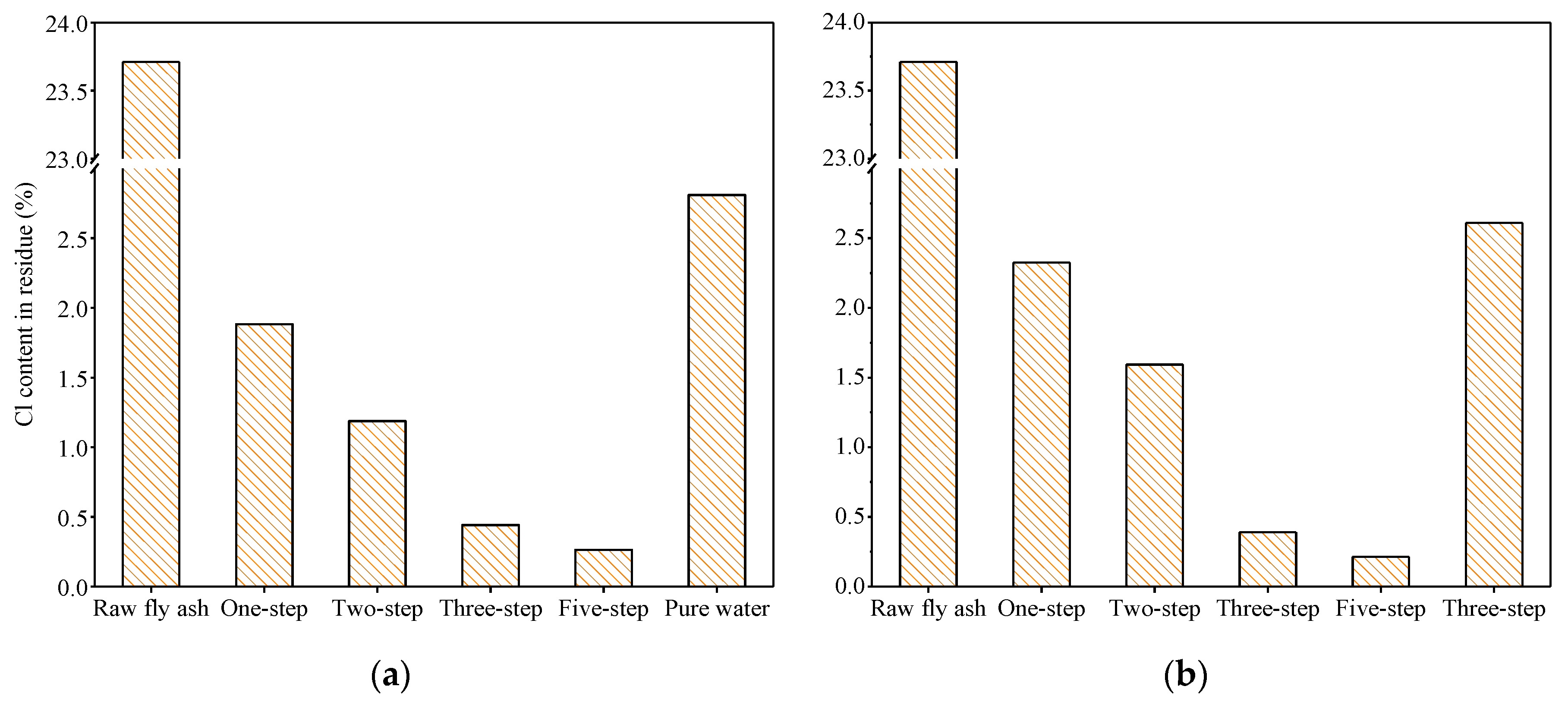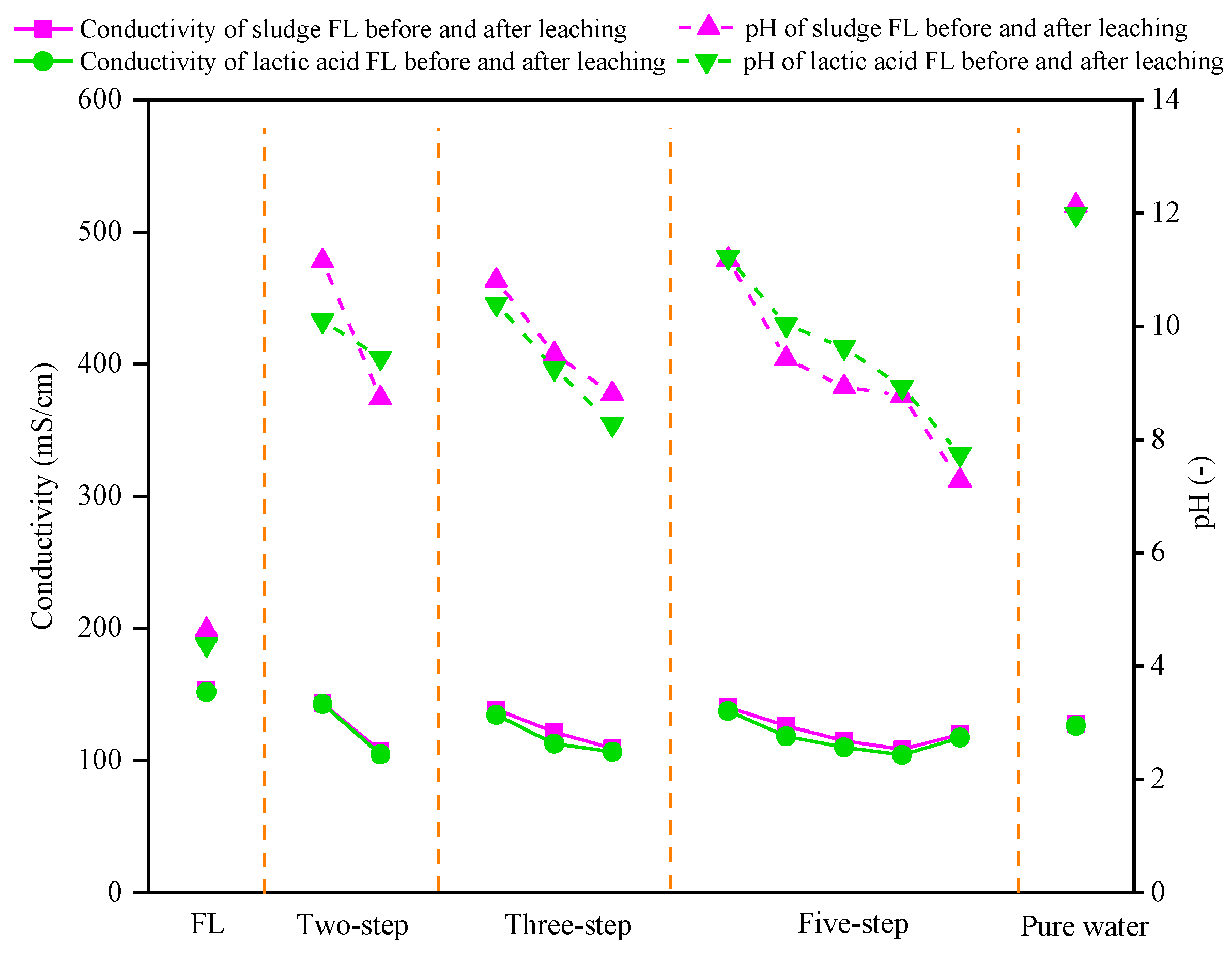Dechlorination of Municipal Solid Waste Incineration Fly Ash by Leaching with Fermentation Liquid of Food Waste
Abstract
1. Introduction
2. Materials and Methods
2.1. Experimental Materials
2.2. Experimental Method
2.2.1. Fermentation Experiment of Food Waste
2.2.2. Dechlorination Experiment of Fly Ash
2.3. Analysis Method
3. Results and Discussion
3.1. Discussion on Best Experimental Conditions for Dechlorination of Fly Ash by Pure Water Leaching
3.2. Dechlorination Effect of Different Leaching Solvents on Fly Ash
3.3. Dechlorination Effect of Different Leaching Steps on Fly Ash
3.4. Cl Content in Leached Fly Ash Residue
3.5. Change in pH Value and Conductivity of Leaching Solvents after Leaching Experiments
3.6. Potential Disposal Scheme for the Leaching Solvents after Leaching Experiments
4. Conclusions
Author Contributions
Funding
Acknowledgments
Conflicts of Interest
References
- Zhao, K.; Hu, Y.; Tian, Y.; Chen, D.; Feng, Y. Chlorine removal from MSWI fly ash by thermal treatment: Effects of iron/aluminum additives. J. Environ. Sci.-China 2020, 88, 112–121. [Google Scholar] [CrossRef]
- Quina, M.J.; Bordado, J.C.M.; Quinta-Ferreira, R.M. Chemical stabilization of air pollution control residues from municipal solid waste incineration. J. Hazard. Mater. 2010, 179, 382–392. [Google Scholar] [CrossRef]
- Yang, R.; Liao, W.; Wu, P. Basic characteristics of leachate produced by various washing processes for MSWI ashes in Taiwan. J. Environ. Manag. 2012, 104, 67–76. [Google Scholar] [CrossRef] [PubMed]
- Xu, P.; Zhao, Q.; Qiu, W.; Xue, Y.; Li, N. Microstructure and Strength of Alkali-Activated Bricks Containing Municipal Solid Waste Incineration (MSWI) Fly Ash Developed as Construction Materials. Sustainability 2019, 11, 1283. [Google Scholar] [CrossRef]
- Rodella, N.; Bosio, A.; Dalipi, R.; Zacco, A.; Borgese, L.; Depero, L.E.; Bontempi, E. Waste silica sources as heavy metal stabilizers for municipal solid waste incineration fly ash. Arab. J. Chem. 2017, 102, S3676–S3681. [Google Scholar] [CrossRef]
- Quina, M.J.; Bontempi, E.; Bogush, A.; Schlumberger, S.; Weibel, G.; Braga, R.; Funari, V.; Hyks, J.; Rasmussen, E.; Lederer, J. Technologies for the management of MSW incineration ashes from gas cleaning: New perspectives on recovery of secondary raw materials and circular economy. Sci. Total Environ. 2018, 635, 526–542. [Google Scholar] [CrossRef]
- Clavier, K.A.; Watts, B.; Liu, Y.; Ferraro, C.C.; Townsend, T.G. Risk and performance assessment of cement made using municipal solid waste incinerator bottom ash as a cement kiln feed. Resour. Conserv. Recycl. 2019, 146, 270–279. [Google Scholar] [CrossRef]
- Golewski, G.L. Green concrete composite incorporating fly ash with high strength and fracture toughness. J. Clean. Prod. 2018, 172, 218–226. [Google Scholar] [CrossRef]
- Lam, C.H.K.; Ip, A.W.M.; Barford, J.P.; McKay, G. Use of Incineration MSW Ash: A Review. Sustainability 2010, 2, 1943–1968. [Google Scholar] [CrossRef]
- Pan, J.R.; Huang, C.; Kuo, J.; Lin, S. Recycling MSWI bottom and fly ash as raw materials for Portland cement. Waste Manag. 2008, 28, 1113–1118. [Google Scholar] [CrossRef]
- Ferreira, C.; Ribeiro, A.; Ottosen, L. Possible applications for municipal solid waste fly ash. J. Hazard. Mater. 2003, 96, 201–216. [Google Scholar] [CrossRef]
- Tyrer, M. 12-Municipal solid waste incinerator (MSWI) concrete. In Eco-Efficient Concrete; Pacheco-Torgal, F., Jalali, S., Labrincha, J., John, V.M., Eds.; Woodhead Publishing: Cambridge, UK, 2013; pp. 273–310. [Google Scholar]
- Wang, Y.; Zhu, H.; Jiang, X.; Lv, G.; Yan, J. Study on the evolution and transformation of Cl during Co-incineration of a mixture of rectification residue and raw meal of a cement kiln. Waste Manag. 2019, 84, 112–118. [Google Scholar] [CrossRef] [PubMed]
- Wu, K.; Shi, H.; Guo, X. Utilization of municipal solid waste incineration fly ash for sulfoaluminate cement clinker production. Waste Manag. 2011, 31, 2001–2008. [Google Scholar] [CrossRef] [PubMed]
- Zhu, F.; Takaoka, M.; Shiota, K.; Oshita, K.; Kitajima, Y. Chloride chemical form in various types of fly ash. Environ. Sci. Technol. 2008, 42, 3932–3937. [Google Scholar] [CrossRef] [PubMed]
- Chen, C.; Chiou, I. Distribution of chloride ion in MSWI bottom ash and de-chlorination performance. J. Hazard. Mater. 2007, 148, 346–352. [Google Scholar] [CrossRef]
- Wu, B.; Wang, D.; Chai, X.; Takahashi, F.; Shimaoka, T. Characterization of chlorine and heavy metals for the potential recycling of bottom ash from municipal solid waste incinerators as cement additives. Front. Environ. Sci. Eng. 2016, 10, 8. [Google Scholar] [CrossRef]
- Joseph, A.M.; Snellings, R.; Van den Heede, P.; Matthys, S.; De Belie, N. The Use of Municipal Solid Waste Incineration Ash in Various Building Materials: A Belgian Point of View. Materials 2018, 11, 141. [Google Scholar] [CrossRef]
- Chimenos, J.M.; Fernandez, A.I.; Cervantes, A.; Miralles, L.; Fernandez, M.A.; Espiell, F. Optimizing the APC residue washing process to minimize the release of chloride and heavy metals. Waste Manag. 2005, 25, 686–693. [Google Scholar] [CrossRef]
- Zuo, X.; Tang, Y.; Yin, G.; Jiang, K.; He, S. Influence of Fly Ash and Its Partial Replacement by Slag on the Leaching Behavior of Blended Cement Pastes. J. Mater. Civ. Eng. 2017, 29, 04017187. [Google Scholar] [CrossRef]
- Ito, R.; Dodbiba, G.; Fujita, T.; Ahn, J.W. Removal of insoluble chloride from bottom ash for recycling. Waste Manag. 2008, 28, 1317–1323. [Google Scholar] [CrossRef]
- Shimaoka, T.; Komiya, T.; Takahashi, F.; Dean, S.W. Dechlorination of Municipal Solid Waste Incineration Residues for Beneficial Reuse as a Resource for Cement. J. ASTM Int. 2011, 8, I103614–I103671. [Google Scholar] [CrossRef]
- Haiying, Z.; Guoxian, M. Leaching of Heavy Metals from Municipal Solid Waste Incineration (MSWI) Fly Ash Using Nitric Acid. Appl. Mech. Mater. 2013, 249–250, 918–921. [Google Scholar]
- Del Toro, M.A.; Calmano, W.; Ecke, H. Wet extraction of heavy metals and chloride from MSWI and straw combustion fly ashes. Waste Manag. 2009, 29, 2494–2499. [Google Scholar] [CrossRef] [PubMed]
- Ren, Y.; Yu, M.; Wu, C.; Wang, Q.; Gao, M.; Huang, Q.; Liu, Y. A comprehensive review on food waste anaerobic digestion: Research updates and tendencies. Bioresour. Technol. 2018, 247, 1069–1076. [Google Scholar] [CrossRef] [PubMed]
- Yin, K.; Chan, W.P.; Dou, X.; Ren, F.; Chang, V.W. Measurements, factor analysis and modeling of element leaching from incineration bottom ashes for quantitative component effects. J. Clean. Prod. 2017, 165, 477–490. [Google Scholar] [CrossRef]
- Wang, Q.; Yang, J.; Wang, Q.; Wu, T. Effects of water-washing pretreatment on bioleaching of heavy metals from municipal solid waste incinerator fly ash. J. Hazard. Mater. 2009, 162, 812–818. [Google Scholar] [CrossRef]
- Lim, S.; Kim, E.; Ahn, Y.; Chang, H. Biological nutrient removal with volatile fatty acids from food wastes in sequencing batch reactor. Korean J. Chem. Eng. 2008, 25, 129–133. [Google Scholar] [CrossRef]
- Boghetich, G.; Liberti, L.; Notarnicola, M.; Palma, M.; Petruzzelli, D. Chloride extraction for quality improvement of municipal solid waste incinerator ash for the concrete industry. Waste Manag. Res. 2005, 23, 57–61. [Google Scholar] [CrossRef]
- Hwang, I.H.; Matsuto, T.; Tanaka, N. Water-soluble characteristics of chlorine in char derived from municipal solid wastes. Waste Manag. 2006, 26, 571–579. [Google Scholar] [CrossRef]
- Huang, K.; Inoue, K.; Harada, H.; Kawakita, H.; Ohto, K. Leaching behavior of heavy metals with hydrochloric acid from fly ash generated in municipal waste incineration plants. Trans. Nonferrous Met. Soc. China 2011, 21, 1422–1427. [Google Scholar] [CrossRef]
- Drobikova, K.; Rozumova, L.; Otoupalikova, H.; Seidlerova, J. Bioleaching of hazardous waste. Chem. Pap. 2015, 69, 1193–1201. [Google Scholar] [CrossRef]
- Xue, Q.; Li, J.; Wang, P.; Liu, L.; Li, Z. Removal of Heavy Metals from Landfill Leachate Using Municipal Solid Waste Incineration Fly Ash as Adsorbent. Clean-Soil Air Water 2014, 42, 1626–1631. [Google Scholar] [CrossRef]
- Atanes, E.; Cuesta-Garcia, B.; Nieto-Marquez, A.; Fernandez-Martinez, F. A mixed separation-immobilization method for soluble salts removal and stabilization of heavy metals in municipal solid waste incineration fly ash. J. Environ. Manag. 2019, 240, 359–367. [Google Scholar] [CrossRef] [PubMed]





| Properties | Unit | Value |
|---|---|---|
| pH | - | 12.8 |
| BET | m2/kg | 912.8 |
| Total Cl | g/(g fly ash) | 0.237 |
| Water-soluble Cl | g/(g fly ash) | 0.207 |
| Water-insoluble Cl | g/(g fly ash) | 0.030 |
| Properties | Value |
|---|---|
| TS (%) | 22.6 ± 0.05 |
| VS (%) | 22.2 ± 0.06 |
| Fat* (%) | 30.82 ± 0.51 |
| Protein* (%) | 14.51 ± 0.07 |
| Carbohydrate* (%) | 44.81 ± 0.03 |
| C* (%) | 48.98 ± 0.04 |
| N* (%) | 2.12 ± 0.14 |
| H* (%) | 7.15 ± 0.15 |
| O* (%) | 30.26 ± 0.17 |
| Type | Concentration (g/L) | |
|---|---|---|
| Lactic Acid Fermentation Group | Sludge Fermentation Group | |
| Lactic acid | 55.6 | 0.7 |
| Formic acid | 1.5 | 0 |
| Acetic acid | 2.1 | 11.6 |
| Propionic acid | 0 | 0.6 |
| N-butyric acid | 0 | 14.7 |
| Leaching Steps | Fly Ash (g) | Leaching Time of Each Step (h) | Leaching Solvents Volume of Each Step (mL) |
|---|---|---|---|
| One-step | 10 | 2 | 100 |
| Two-step | 10 | 1 | 50 |
| Three-step | 10 | 0.67 | 33 |
| Five-step | 10 | 0.4 | 20 |
| Leaching Steps | The Cl Content in the Residue (%) | The water-Insoluble Cl Removal Percentage (%) | Permissible Added Fraction of Leaching Residue* (%) | Increase in the Permissible Added Fraction of Leaching Residue** (%) | |
|---|---|---|---|---|---|
| Pure water | Three-step | 2.81 | 6.68 | 0.72 | - |
| Lactic acid fermentation liquid | One-step | 1.88 | 43.33 | 1.09 | 0.37 |
| Two-step | 1.18 | 70.00 | 1.75 | 1.03 | |
| Three-step | 0.44 | 90.00 | 5.00 | 4.28 | |
| Five-step | 0.26 | 93.33 | 9.09 | 8.37 | |
| Sludge fermentation liquid | One-step | 2.33 | 40.00 | 0.87 | 0.15 |
| Two-step | 1.59 | 60.00 | 1.29 | 0.57 | |
| Three-step | 0.39 | 90.00 | 5.71 | 4.99 | |
| Five-step | 0.21 | 93.33 | 11.76 | 11.04 |
© 2020 by the authors. Licensee MDPI, Basel, Switzerland. This article is an open access article distributed under the terms and conditions of the Creative Commons Attribution (CC BY) license (http://creativecommons.org/licenses/by/4.0/).
Share and Cite
Zou, D.; Wang, X.; Wu, C.; Li, T.; Wang, M.; Liu, S.; Wang, Q.; Shimaoka, T. Dechlorination of Municipal Solid Waste Incineration Fly Ash by Leaching with Fermentation Liquid of Food Waste. Sustainability 2020, 12, 4389. https://doi.org/10.3390/su12114389
Zou D, Wang X, Wu C, Li T, Wang M, Liu S, Wang Q, Shimaoka T. Dechlorination of Municipal Solid Waste Incineration Fly Ash by Leaching with Fermentation Liquid of Food Waste. Sustainability. 2020; 12(11):4389. https://doi.org/10.3390/su12114389
Chicago/Turabian StyleZou, Dezhi, Xiaona Wang, Chuanfu Wu, Teng Li, Menglu Wang, Shu Liu, Qunhui Wang, and Takayuki Shimaoka. 2020. "Dechlorination of Municipal Solid Waste Incineration Fly Ash by Leaching with Fermentation Liquid of Food Waste" Sustainability 12, no. 11: 4389. https://doi.org/10.3390/su12114389
APA StyleZou, D., Wang, X., Wu, C., Li, T., Wang, M., Liu, S., Wang, Q., & Shimaoka, T. (2020). Dechlorination of Municipal Solid Waste Incineration Fly Ash by Leaching with Fermentation Liquid of Food Waste. Sustainability, 12(11), 4389. https://doi.org/10.3390/su12114389





